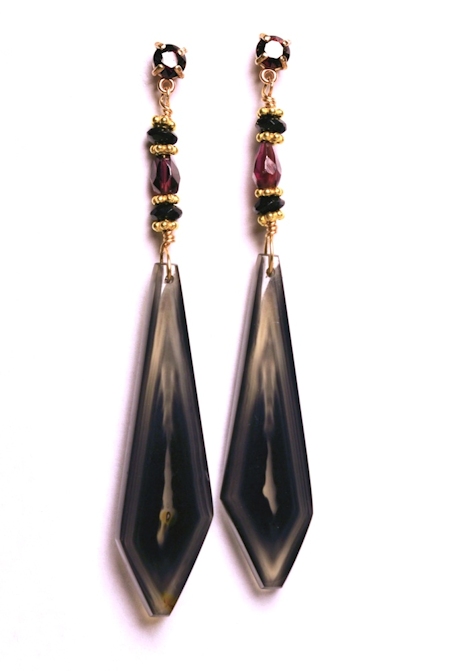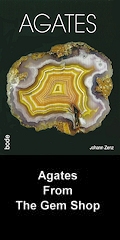In his first Agates book, Zenz talks about the discovery of geometrically-shaped agates like the one from which these earring stones were sliced: "The impossible seemed to have happened, for most agates usually appeared in nodules, balls or irregular tunnels. Agates take on a crystalline form? Experts soon realized that these pieces could not be 'agate crystals' as their angles were totally irregular and no crystal shape could be determined..." Brzys mentions there are at least two theories of how they form, some think they are pseudomorph replacements of more angular crystals; others think these agates grew in hollow spaces between other crystals like calcite.
The only known significant deposit of polyhedroids was found in a single location in the Paraiba area of Brazil and it was only mined in the '70s, so examples are becoming more and more difficult to find. Mayer says there is no new material coming from the region. Brzys says that "believe it or not" a few have been found in Iowa, Minnesota, the Lake Superior region and Wyoming (combining information from her table and her discussion which don't match).
Most polyhedroids are not symmetrical like these earring stones, and few are small enough for jewelry, so these are a real find. Incidentally, it may appear from the photograph that the centers are hollow but they are not. The centers are completely filled in with clear agate.
The name 'polyhedroid' sounds like it must mean 'polyhedron-like' (since '-oid' is a suffix meaning 'like' or 'resembling'). While we're taking the word apart, 'poly' means 'many' (you knew that) and '-hedron' means 'base' or 'face'. To review our high school geometry, a polyhedron is a solid in three dimensions with flat faces and straight edges, like those cool paper models we all used to make. Surely these rocks are "like polyhedrons"??? Yes, but... Wikitionary gives only one definition of polyhedroid (from mathematics, not geology) which is 'polychoron' where '-choron' comes from the Greek meaning 'room.' Specifically a polychoron/polyhedroid is a four-dimensional polytope. 'Polytope' means 'many-surface' and is the general term describing the infinite sequence "point, line, polygon, polyhedron, polychoron [or polyhedroid],..." The wiki article on polychoron mentions that as you would expect, "Polychora can not be seen in three-dimensional space due to their extra dimension." (Watch as I spare both of us a discussion of how the plural of an '-on' word could end in '-a'.) However, techniques exist to help visualize them, one called "sectioning" equates the fourth dimension with time to help visualize their shape. This polyhedroid adventure turned out to be more strange than I expected!
After delving into the name as best I could on line, I looked on my bookshelf and discovered that Brad Cross and June Culp Zeitner addressed the very question of the name's meaning in Geodes! Here's the official story: "The name, 'polyhedroids,' was given to the objects by J. L. Daniels because they are similar to, but not completely identical with, solids of many faces having no geometrical regularity." Ahhh... I think what they meant to say is that the polyhedroids have no geometrical regularity, that's why they're only similar to but not completely identical with polyhedrons. We have to go back to Zenz to discover that one J. L. Daniels wrote an article on polyhedroids for Lapidary Journal 28 (9), 1974. Apparently my first assumption was correct, but let's just consider equating that fourth dimension with time... Determining the age of agates is difficult because of the dearth of radioactive markers in them. Furthermore, some have been shown to be significantly younger than their host rock so the age of the surrounding rock is not conclusive. Brzys offers pages of fascinating discussion about the various geologic transformations we think produced the chalcedony we call agate. She provides a table of the estimated age of various agates ranging from the youngest at Yucca Mountain in Nevada (9-13 million years) to 3.4 billion years for the Western Australia agates in the Pibara Craton. Brazilian agates seem to be in the 100 - 200 million-year-old range.
So did J. L. Daniels make a little boo-boo in calling these ancient stones 'polyhedroids' without realizing that word had a precise meaning in mathematics? Maybe. But given how long it takes for an agate to form, and how old these rocks are, perhaps a fourth dimension equating to time ought to be referenced in the name. Just imagine being able to wear 4-dimensional earrings!
We can't omit a discussion of the Ant Hill Garnets that sparkle on the ear posts. It isn't a joke, in Navajo country Arizona chrome pryope garnets are found in ants' excavation debris. One web site claims the color of the Arizona Garnet rivals that of some of the finest rubies in the world. Ahsian says, "it allows one to open to the channel of Divine Love that constantly streams from the Source."





